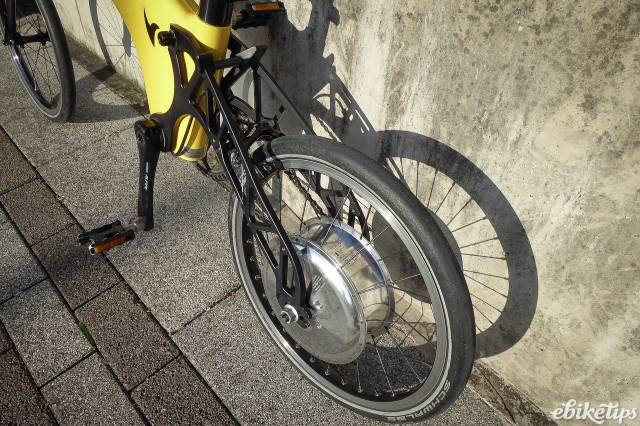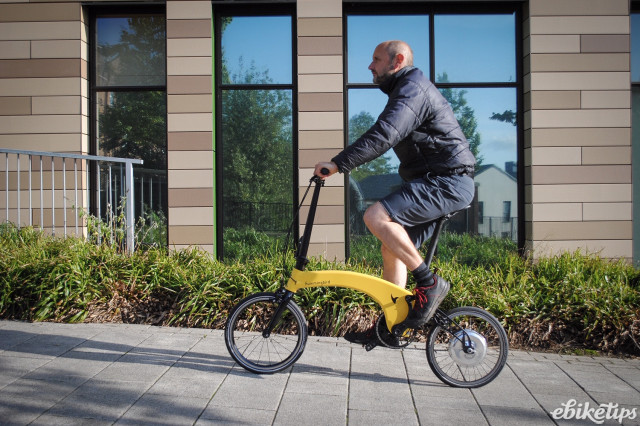Hummingbird Electric

Overview
- Extremely light
- Fast, sporty ride
- Cool, minimalist folding design
- Lack of power for steep climbs
- Hefty price tag
The electric version of the Hummingbird folder blends the original non-electric design with the installation of an ‘all-in-one’ rear motor hub from Zehus which contains all the electric elements needed to power a bike, with power levels and other settings controlled remotely from a smartphone app.
Buy the Hummingbird Electric Here
The Hummingbird folder is the brainchild of Romanian Petre Craciun, and was actually born out of a product design study whilst he was a student. It originally appeared in production form as a non-electric lightweight folder weighing an astonishing 6.9kg. The stated weight of the Zehus all-in-one motor system is 3.5kg, but the total weight of my test bike for some reason was a little more than the sum of the two, coming in at 10.9kg. Still, that’s an incredibly light e-bike.
Lightweight Folding Carbon Fibre Design
Whilst the Zehus system is fitted to several other bike brands, the Hummingbird itself is a truly unique design. There’s plenty of carbon fibre in evidence from the graceful, curving monocoque frame to the front fork and seatpost. Hummingbird are based in the automotive specialist manufacturer Prodrive’s Banbury plant where they can tap into the company’s renowned expertise in the area of carbon fibre part manufacture, so the underlying quality of materials should be every bit as good as the impressive finish.
The rear frame member is made of CNC-machined aluminium and hinges around the main carbon-fibre element using a quick-release skewer. Once released this allows the rear wheel to swing under the frame with the seatpost dropping down and the handlebar post dropping to the side to secure the bottom frame member. This produces a longish but thin and very light folded package at 115cm long x 63 cm tall x 20cm wide. A nice touch is that the quick release pedals slot into the underside of folded rear frame for easy storage.
Whilst this isn’t as compact as, say, a Brompton (few folders are) and might mean the bike doesn’t fit into smaller luggage compartments on busy trains for example, it is a very light and firmly held together package that makes it the easiest e-bike in folded form to manhandle and lift above waist level that I have yet tried. It’s also nice and easy to carry through narrow doorways. Of course, folded or unfolded, it’s the kind of weight that most riders can carry up steps too.
The ‘partial’ folds – either dropping the handlebars or tucking the rear end under the carbon fibre main frame – are also very useful for where either width or length need to be quickly reduced; for example, getting into a small lift or storing the bike in a hallway. Note the non-electric single speed (see the summary section below) is designed so the quickly released front wheel can be removed and quickly fastened onto the rear frame for a wider but shorter package, but this can’t be done with the electric version.
All-in-one: pros and cons
The Zehus system has been around for quite some time; in fact, its launch preceded the extremely well publicised Copenhagen Wheel by some three years. Alhough it never got the high profile publicity of its rival, Zehus appears to have a more solid track record when it comes to the list of bike brands that have adopted it, ranging from the Dutch giant Sparta to the niche London Fixed Gear.
As the ‘all-in one’ popularly adopted moniker suggests, Zehus contains all the elements of an e-bike system needed to power a bike – controller, batteries and motor – all within a single (pretty large) rear wheel hub. Advantages and disadvantages tend to be inherent in many ‘all-in-one’ designs; the advantages being ease of installation on a large range of (otherwise unpowered) bikes, lack of wire runs and lack of any exposed parts that can get damaged or wet, and the disadvantages being that the weight is concentrated all in one place, the small battery capacity due to lack of space and not being able to swap out the battery.
The battery capacity issue (the current version packs a relatively small 155Wh lithium-ion battery) is being addressed, as the Zehus Gen 2 was announced at the end of September and features greater capacity, along with more torque and a remote control handlebar button. Note one advantage of the current 155Wh battery is that is comes in just below the 160Wh limit allowance for lithium ion batteries allowed in commercial aircraft holds. Unfortunately the Zehus battery is not removable (by the consumer at least), and so it’s not possible to carry a spare to extend the range.
The ride
If you ride this bike even on a moderate power setting it really feels fast and solid. As you might expect from a top quality carbon fibre frame, there is plenty of stiffness that transmits pedal power into wheel speed and the 16” (Brompton-sized) Schwalbe Kojak tyres roll freely. Everything else is designed to shave weight, from the hollow pins in the chain to the titanium seat detailing. With the single speed 65 inch gear I maxed out at around 29kmh (18mph) on the flat, with legs spinning somewhat frantically to keep up this speed. 25kmh is a more comfortable speed to maintain for longer periods, in my opinion.
Even with power set at a fairly lowly 30% the bike flies along the flat and breezes up moderate hills, though the lack of raw power means you find yourself getting out of the saddle to step on the pedals uphill unless you're in the top power settings. On my ride up steeper, hilly Pennine foothills on the highest power setting, I needed to put in a significant amount of human power but still managed to crest numerous steep hills, though I was getting a very good workout in the process.
This is all part of the compromise you make in having a sub 11kg electric folding bike; gearless motors are not the best climbers, and the relatively small space for motor hardware inside the hub means the Zehus is less powerful than gearless motors with separate battery and controller systems. The 20Nm or so of torque is still a welcome addition to you own input.
Good news for those who want to ride unassisted on occasions is the fact that the rear wheel can be swapped out for a regular wheel. This results in the regular sub-7kg Hummingbird folding bike that rides even faster, until you hit hills and headwinds of course!
As the Zehus system utilises a gearless motor it can and does feature regenerative braking; when you back pedal the motor acts as a generator rather than consumer of electricity and puts some charge back into the battery; it’s the wheel resistance you feel while in regen mode that creates the charge and results in miraculous feeling braking force even though you aren’t touching the brake levers. On the Zehus system the regen is activated by turning the pedals backwards, in the style of a coaster brake.
Whilst this feels really efficient while riding, the actual amount of power put back into the motor is minimal for simple reasons dictated by the laws of physics; however it does save some wear and tear on your brake pads and rims, although it weakens significantly at higher speeds which for me made the whole effect rather disappointing. Still, if you don’t get on with it you can just turn it off completely inside the Bitride app.
Whilst the Hummingbird Electric doesn’t excel in very hilly country it does gobble up more moderate hills, folds down pretty quickly and easily and is wonderfully light to carry about when folded, making an ideal ‘multi-modal’ commuter for many if not all UK cities. I would like to see Hummingbird perhaps develop some sleek and lightweight extras such as mudguards or kickstands, in the same minimalist vein as the bike itself.
Controlling with connectivity
The Bitride app is free on Android and iOS, allowing you to control top-assisted speed (maxing out at 25kmh), power assist level and regenerative braking effort. There’s also a battery capacity bar along the bottom of the home screen, and a small but neat power meter that lets you see what is presumably the amount of watts being generated by the motor.
There’s no fixings provided to mount your smartphone onto the bars should you wish to adjust the settings on the fly, though there are plenty of after-market solutions available. With both motor power and regenerative braking on the Zehus system being relatively subtle, I was quite happy to set power to 100% in very hilly terrain and 50% otherwise while leaving the regen off, not wanting to trigger it accidentally with a slight back pedal.
After the initial setup requiring the usual basic details to register and a PIN to access your own unique account, the bluetooth link with the bike worked very smoothly. The only occasional cut outs it suffered were when I stopped to change the power level. This can only be done when stopped, and Hummingbird says this is a safety feature to stop the rider operating a phone while riding. The forthcoming second generation of the Zehus system has a wireless handlebar control for altering settings whilst riding that would solve this problem, and Hummingbird say they're looking into using this system.
Summary
A two speed Brompton Electric weighs 16.6kg and costs £2,595, and the folding GoCycle GX weighs 18.78 and costs £2,899. Even various as yet unproven e-folder models from the hype-infested world of crowdfunding don’t come anywhere close to the Hummingbird Electric in terms of low weight. At 10.9kg and £4,495, the Hummingbird Electric is definitely a case of less weight = more money. If you want something lighter for less cash and without electric assist, Hummingbird produce ‘conventional’ (ie non-electric) single-speed and four- speed versions: the 6.9kg single speed is £3495 and the 8.2kg geared bike is £3745 according to their website.
If you value light weight above motor power and range and have deep pockets, the Hummingbird Electric is most definitely worth considering. Indeed, if you want a fast-riding, very lightweight folding e-bike there really is very little competition.














